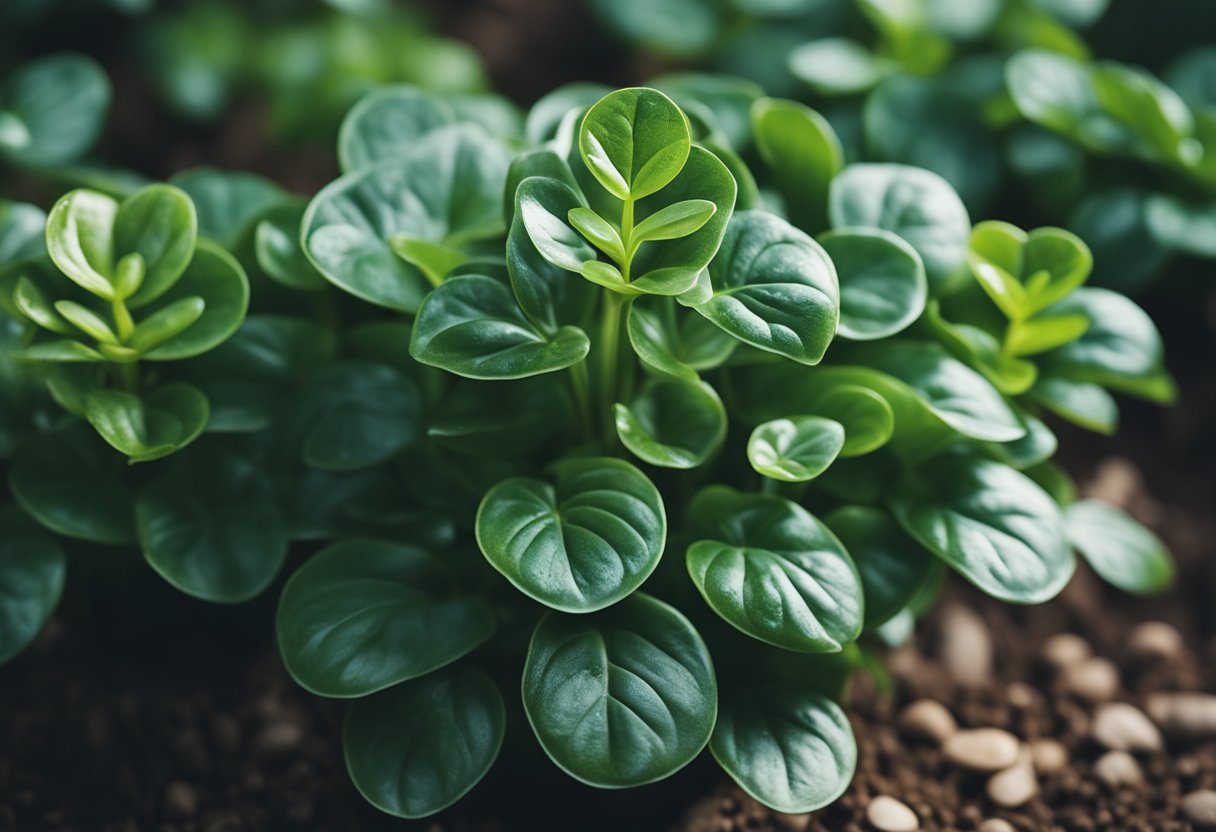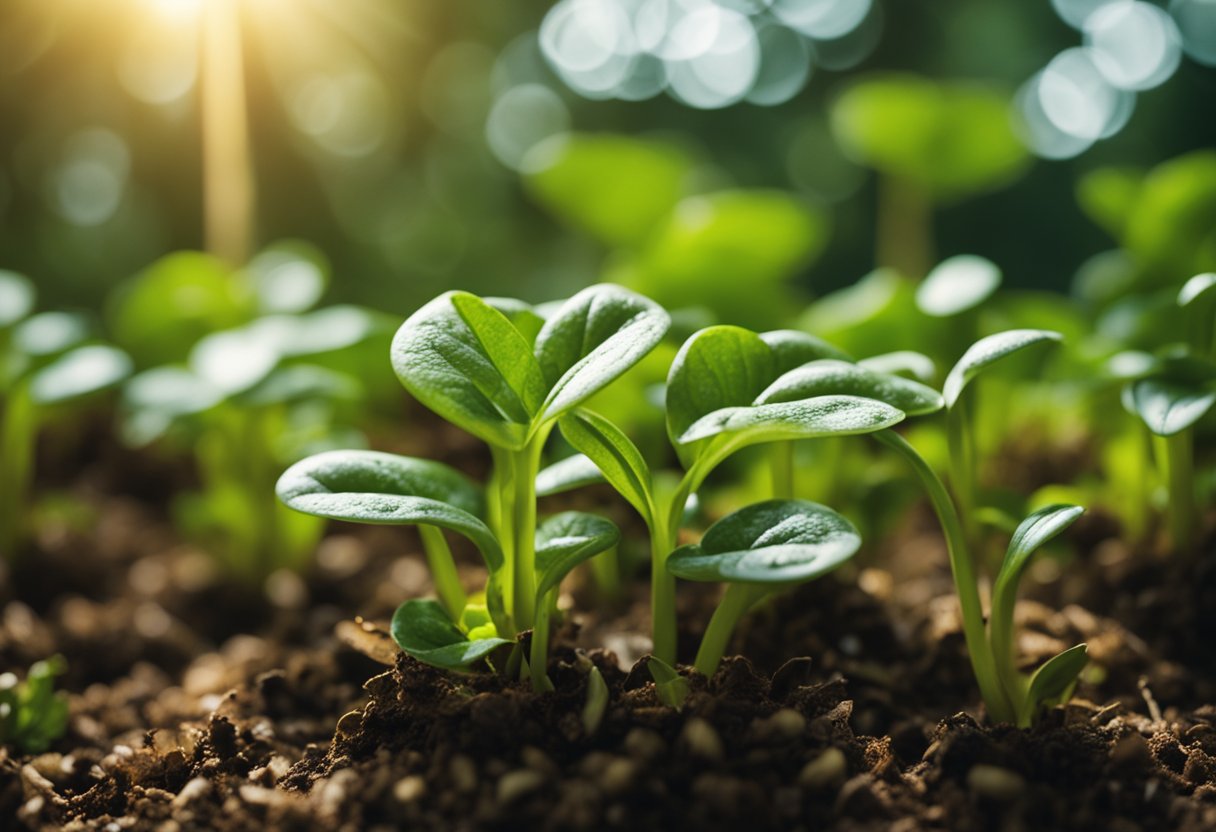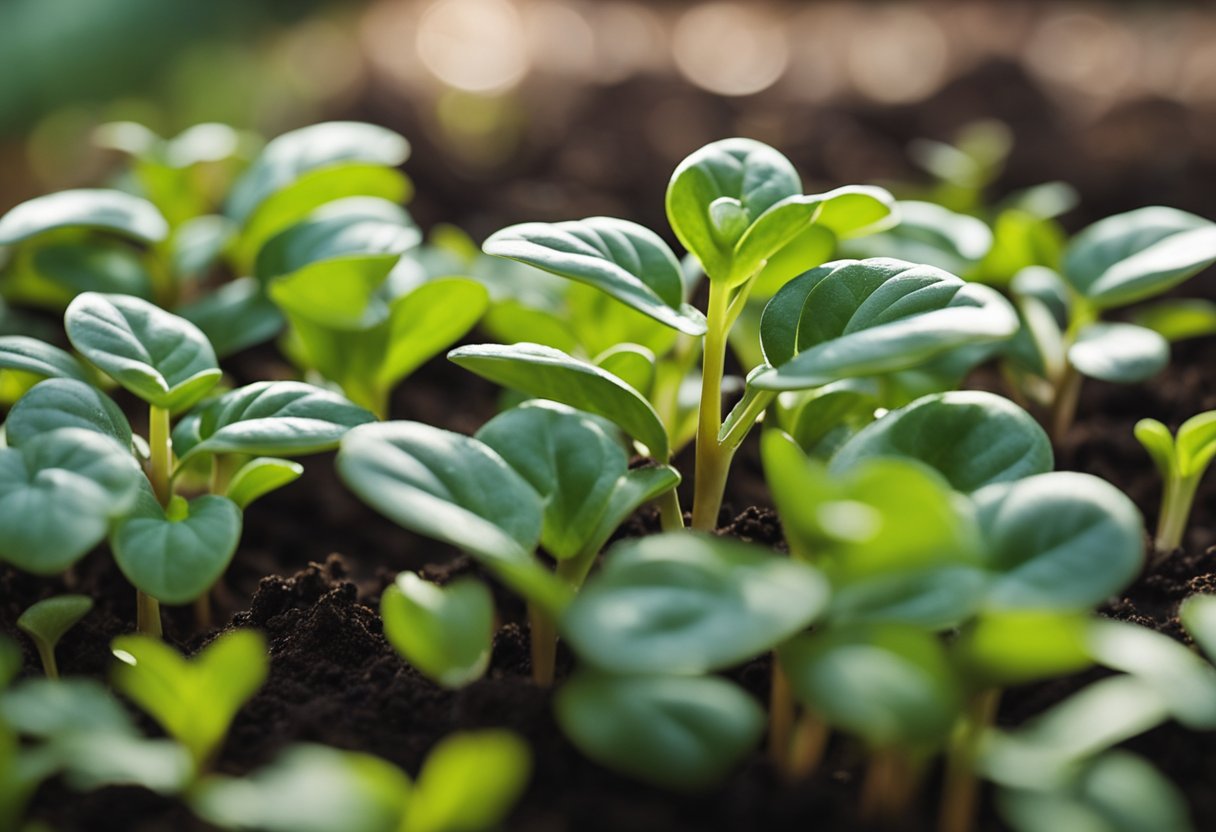Best Soil for Peperomia: A Comprehensive Guide
Peperomia is a popular houseplant species that belongs to the Piperaceae family. This low-maintenance perennial is native to Central and South America and is known for its unique foliage and easy care requirements. With over 1,000 known species, there is a peperomia plant for every taste and preference.
This post may contain affiliate links, which means I’ll receive a commission if you purchase through my link, at no extra cost to you. Please read full disclosure here.

One of the most important factors in keeping peperomia plants healthy is providing them with the right soil. Peperomia thrives in a well-draining soil mix that is rich in organic matter. The soil must retain enough moisture for the plant to absorb, but at the same time, it must not be too heavy. A combination of regular potting soil with some coco coir, perlite, or barks works well. The type of soil, such as sand, clay, loamy, peaty, or chalky, depends on the size and texture of the particles it contains. The three common particle types are sand, silt, and clay. Sandy soil drains very quickly and offers large pores for excellent aeration. Sandy soil doesn’t hold onto water or nutrients well.
Understanding Peperomia’s Natural Habitat

Peperomia is a tropical plant that is native to Central and South America. It is found in the understory of the rainforest, where it grows under the shade of taller trees. As a result, it is adapted to living in low light conditions and prefers indirect light.
Peperomia plants thrive in temperatures between 60 and 75 degrees Fahrenheit. They can tolerate temperatures as low as 50 degrees Fahrenheit, but they are susceptible to frost damage. On the other hand, temperatures above 75 degrees Fahrenheit can cause the plant to wilt and become stressed.
Peperomia plants prefer high humidity levels, which is why they are commonly found in rainforests. They can tolerate lower humidity levels, but they are more prone to drying out and becoming stressed. To maintain the right humidity level, it is recommended to mist the plant regularly or place it on a tray filled with pebbles and water.
When it comes to light, Peperomia plants prefer indirect light. Direct sunlight can scorch the leaves and cause them to turn yellow. However, they still need some light to photosynthesize and grow. It is recommended to place them near a window that receives bright but filtered light.
In conclusion, understanding the natural habitat of Peperomia plants can help you create the ideal growing conditions. They prefer low light, high humidity, and indirect light. It is important to maintain the right temperature and avoid exposing them to direct sunlight.
The Importance of Soil for Peperomia

Peperomia plants are relatively easy to care for, but one of the most critical factors in ensuring their health and longevity is the soil they are planted in. The right soil mix can help ensure that your peperomia grows strong and healthy, while the wrong soil can lead to root rot, wilting, and other issues.
One of the most important factors to consider when choosing soil for your peperomia is drainage. Peperomia plants do not like to sit in wet soil, and overly wet soil can quickly lead to root rot. It is essential to choose a soil mix that allows water to drain away from the roots quickly. This can be achieved by using a soil mix that contains plenty of coarse materials like perlite, sand, or gravel.
Another critical factor to consider is aeration. Peperomia plants need plenty of air around their roots to thrive, and soil that is too dense or compacted can lead to suffocation and poor growth. A good soil mix should contain plenty of organic matter like compost or peat moss, which can help keep the soil loose and airy.
The type of soil you choose is also important. Peperomia plants generally prefer a soil mix that is rich in organic matter but well-draining. A good peperomia soil mix might include a combination of regular potting soil, coco coir, perlite, or bark. Loamy soil is also an excellent choice for peperomia plants, as it contains a balance of sand, clay, and silt that allows for good drainage and aeration.
The pH of the soil is also important. Peperomia plants prefer soil that is slightly acidic, with a pH between 5.5 and 6.5. If the soil is too alkaline, it can lead to nutrient deficiencies and poor growth. It is essential to choose a soil mix that is within the appropriate pH range for your peperomia plant.
In summary, choosing the right soil for your peperomia plant is essential for its health and growth. A good peperomia soil mix should be well-draining, aerated, and rich in organic matter. It should also be within the appropriate pH range for your plant. By taking the time to choose the right soil mix, you can help ensure that your peperomia plant thrives for years to come.
Ideal Soil Composition for Peperomia
Peperomia plants thrive in well-draining soil that is rich in organic matter. The ideal soil composition for Peperomia should retain enough moisture for the plant to absorb, but at the same time, it must not be too heavy.
A combination of regular potting soil with some coco coir, perlite, or barks works well. Peat moss is another essential component that helps to retain moisture in the soil. The pH level of the soil should be between 5.5 and 7.0, which is slightly acidic to neutral.
Adding sand to the soil mix can improve drainage, while pumice, vermiculite, or orchid bark can improve aeration. Compost is also an excellent addition to the soil mix, as it adds nutrients and organic matter to the soil.
Cactus soil is another option for Peperomia plants, as it is formulated to provide excellent drainage. It contains a mix of sand, perlite, and other minerals that help to prevent soil compaction. Styrofoam can also be added to the soil mix to improve drainage and aeration.
Coconut coir and pine bark are other organic materials that can be added to the soil mix to improve water retention and aeration. They are also sustainable alternatives to peat moss.
In summary, the ideal soil composition for Peperomia plants should be well-draining, organic-rich, and slightly acidic to neutral. It should contain a mix of potting soil, peat moss, coco coir, perlite, sand, pumice, vermiculite, orchid bark, compost, and other organic matter. The pH level of the soil should be between 5.5 and 7.0.
Factors Affecting Soil Choice
Choosing the right soil for Peperomia is crucial for their growth and survival. The following factors should be considered when selecting soil for Peperomia:
Watering and Moisture Retention
Peperomia plants require well-draining soil to avoid waterlogging, which can lead to root rot. Soil that retains too much moisture can suffocate the roots and prevent the plant from absorbing nutrients. Therefore, it is essential to choose a soil mix that allows excess water to drain away from the roots while still retaining enough moisture to keep the soil moist.
Air and Humidity
Peperomia plants require adequate air circulation around their roots to prevent the buildup of harmful gases. The soil should be aerated to allow air to flow freely around the roots. Additionally, Peperomia plants thrive in environments with high humidity levels. Choosing a soil mix that retains moisture can help to create the ideal humidity levels for Peperomia plants.
Disease, Pests, and Fungus
Peperomia plants are prone to fungal infections, pests, and diseases. Therefore, it is essential to choose a soil mix that is free of contaminants and pathogens. Additionally, soil mixtures that contain perlite, vermiculite, or sand can help to prevent fungal growth and pest infestations.
Temperature and Season
Peperomia plants prefer temperatures between 60°F and 75°F. Therefore, it is essential to choose a soil mix that can maintain a consistent temperature throughout the year. Additionally, the soil mix may need to be adjusted depending on the season. During the winter months, a soil mix that retains moisture can help to prevent the soil from drying out. In contrast, during the summer months, a soil mix that drains quickly can help to prevent waterlogging.
In summary, choosing the right soil for Peperomia plants requires careful consideration of various factors, including watering and moisture retention, air and humidity, disease, pests, and fungus, and temperature and season. By selecting the appropriate soil mix, Peperomia plants can thrive and grow to their full potential.
Choosing the Right Potting Mix
Peperomia plants thrive in well-draining soil that allows air to circulate around their roots. A good potting mix for Peperomia should be light, porous, and able to retain moisture without becoming waterlogged.
Many gardeners recommend using a mix of peat moss, vermiculite, and perlite to create an appropriate potting mix for Peperomia. This combination provides excellent aeration and drainage while retaining enough moisture to keep the plant healthy.
It’s important to note that the soil loses nutrients over time, so it’s best to provide the plant with a continuous supply of fertilizer. FoxFarm Ocean Forest is a popular potting soil that contains a blend of organic materials and nutrients that can help Peperomia plants thrive.
When fertilizing Peperomia, it’s important to use a balanced fertilizer that contains equal parts nitrogen, phosphorus, and potassium. Over-fertilizing can lead to burned roots and stunted growth, so it’s best to err on the side of caution and fertilize sparingly.
In summary, choosing the right potting mix for Peperomia involves selecting a well-draining soil that allows air to circulate around the roots while retaining enough moisture to keep the plant healthy. Adding a continuous supply of fertilizer, such as FoxFarm Ocean Forest, can help ensure that the plant receives the nutrients it needs to thrive.
Caring for Your Peperomia
Peperomia is a low-maintenance houseplant that is perfect for beginners. It is known for its fleshy leaves that come in various shades of green and other colors. Peperomia can also produce small flowers, although they are not the main attraction of the plant.
To keep your peperomia healthy, it is important to provide it with the right growing conditions. Peperomia prefers medium to bright indirect light and should be protected from direct sunlight. It is also important to choose a potting mix that is loose and well-draining but still retains moisture well. A combination of soil, perlite, and peat moss is recommended.
Peperomia does not like to be overwatered, so it is important to allow the soil to dry slightly between waterings. Overwatering can lead to root rot and other diseases. If you notice the leaves wilting or turning yellow, it may be a sign that the plant is not getting enough water or is suffering from root rot.
Repotting peperomia should be done when the plant outgrows its current pot or when the soil becomes too compacted. When repotting, it is important to choose a pot that is only slightly larger than the current one. Peperomia prefers to be slightly root-bound, and a pot that is too large can lead to overwatering and other problems.
Pruning is not necessary for peperomia, but it can help to keep the plant looking neat and tidy. If the plant becomes too leggy or starts to lose its shape, you can trim back the stems to encourage bushier growth.
Propagating peperomia is easy and can be done by taking stem cuttings. Simply cut a stem with a few leaves and place it in a pot with moist soil. Keep the soil moist and the cutting should root within a few weeks.
Overall, peperomia is a great houseplant that can grow up to 12 inches tall. With the right care, it can thrive and provide beautiful foliage for years to come.
Common Peperomia Varieties
Peperomia is a genus of plants that includes over 1500 species. Some of the most common varieties of peperomia include Peperomia Obtusifolia, Peperomia Caperata, Peperomia Rosso, and Peperomia Argyreia.
Peperomia Obtusifolia, also known as baby rubber plant, is a slow-growing plant that is easy to care for. It has round leaves that are thick and fleshy, making it drought-tolerant. This variety of peperomia prefers well-draining soil that is rich in organic matter.
Peperomia Caperata, also known as ripple peperomia, is a compact plant that has wavy, crinkled leaves. It is a slow-growing plant that is ideal for small spaces. This variety of peperomia prefers well-draining soil that is kept slightly moist.
Peperomia Rosso, also known as radiator plant, is a compact plant that has dark green leaves with red undersides. It is a slow-growing plant that is ideal for small spaces. This variety of peperomia prefers well-draining soil that is kept slightly moist.
Peperomia Argyreia, also known as watermelon peperomia, is a slow-growing plant that has round leaves with silver stripes. This variety of peperomia prefers well-draining soil that is kept slightly moist.
Overall, peperomia is a versatile plant that comes in many different varieties. Whether you prefer slow-growing plants with round leaves or compact plants with wavy leaves, there is a peperomia variety that is perfect for you.